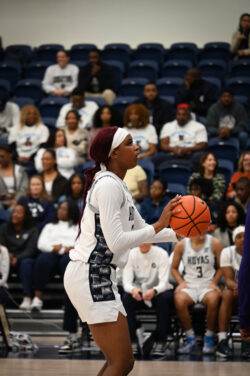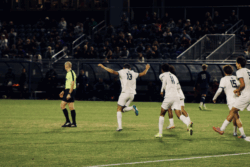If there is one thing to blame for the Hoyas’ recent struggles, it is zone defense. Both Notre Dame and Syracuse used zone to neutralize the Hoyas dominant low-post players and prevent the Hoya guards from using their penetration abilities to get to the basket.
By playing zone, the Orangemen and Fighting Irish gave the Hoyas better opportunities to crash the offensive glass, as Georgetown piled up a combined 37 offensive rebounds. (Notre Dame was actually quite impressive on the glass, but Georgetown’s 15 second-chance points were a major reason the Hoyas grabbed the lead.)
This downside to playing zone really isn’t that dramatic because the Hoyas would likely control the glass anyway. Last season, the Hoyas finally made teams pay for playing zone by exploiting the offensive talent of Lee Scruggs.
Compared to last year, Scruggs has been slowly integrated into the Hoya offense because the Hoyas have not been as desperate for his offense in most games. Instead of using him inside, Scruggs has become more of a novelty act, shooting an enormous number of three pointers.
Scruggs can shoot, but the Hoyas have a few other three-point aces this season. Against man-to-man defense, starting power forward Mike Sweetney is even stronger than Scruggs with his ability to get open for layups and dunks inside. Against zone, Sweetney is hard to utilize because zones close down entry lanes and swarm the post.
Scruggs, with his wiry 6’11” frame, is easy to hit in both the high post and on the baseline. The fact that he can hit the medium range jumpers forces zone defenses to collapse on him. So far this season, Scruggs has been about as likely to throw the ball out of bounds as to a teammate?let alone pass for an assist.
Scruggs’ erratic passing isn’t some sort of character flaw or virus. He proved last year that he can move the ball effectively. The logical reason for his difficulty this year is the fact that he still hasn’t fit into the new, improved Hoya team.
If the Hoyas want to crack zones, they are either going to have more than one of their three-point gunners shoot opponents out of zones, or they are going to have to put Scruggs to work. Against UNLV, Scruggs was struggling and Wesley Wilson was on fire, but Scruggs needed a few more minutes.
Last season, Scruggs and Ruben Boumtje-Boumtje formed an interchangable high-post-low-post arrangement. Adjusting their locations almost always opened up holes in opponents’ zones.
If Boumtje-Boumtje keeps struggling, the Hoyas lose the interchangable nature of the high-low arrangement because Sweetney is much more effective down low than he is near the free-throw line. It’s also harder to get him the ball in the center of a zone because he is only 6’8”. Wilson has the raw ability to play both the high and low spots, but his inexperience makes him less effective when three defenders collapse on his location.
Georgetown’s own zone defense has also been a problem for the Hoyas. It’s not very dramatic in comparison to the team’s struggles against Syracuse’s famous 2-3, but the Hoyas are having trouble hiding the downside to their beefy front line?an inability to manage forwards that can handle the ball.
Syracuse’s Damone Brown made it extremely hard for the Hoyas to play man-to-man defense, because he is essentially a small forward. Sweetney is just too large to keep up with him. As a result, Georgetown had to rely on more zone than usual. The result was an inability to force turnovers or keep the small Orangemen off the offensive glass.
In short: Georgetown’s zone defense is killing their fast-break offense. Need some proof? When was the last time Demetrius Hunter got free for one of his famous dunks? Hunter has been on his game lately, but his usual quota of one highlight dunk per half of play has tapered off.




